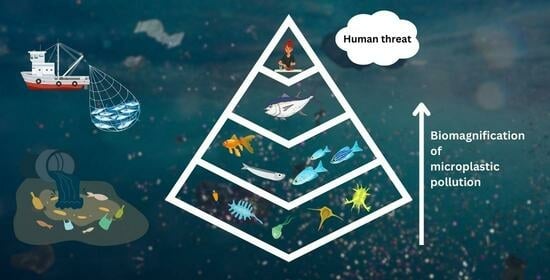An Assessment of Microplastic Contamination in a Commercially Important Marine Fish, Harpadon nehereus (Hamilton, 1822)
Abstract
:1. Introduction
2. Materials and Methods
2.1. Study Area and Specimen Collection
2.2. MPs Extraction
2.3. Identification and Categorization of MPs
2.4. Contamination Control
2.5. Data Analysis
3. Results
3.1. Abundance of MPs
3.2. Physical and Chemical Characterization of MPs
4. Discussion
4.1. Abundance of MPs in H. nehereus
| No. | Location | Species | Habitat | Feeding Strategy | MPs in Fish (MPs/g) | Dominant MP Type | References |
|---|---|---|---|---|---|---|---|
| 1 | Northwest coast of India | H. nehereus | Pelagic | Carnivore | 6.98 ± 6.73 | 98% Fibers | Present study |
| 2 | Portuguese coast | A. regius | Benthopelagic | Carnivore | 0.80 ± 0.8 | 65.8% Fibers | [18] |
| M. merluccius | Bathydemersal | Carnivore | 0.40 ± 0.89 | ||||
| S. japonicus | Pelagic–neritic | Omnivorous | 0.57 ± 1.04 | ||||
| T. lyra | Benthopelagic | Carnivore | 0.26 ± 0.57 | ||||
| B. boops | Demersal | Omnivorous | 0.09 ± 0.3 | ||||
| 3 | Australia and Fiji | Plectropomus leopardus | Reef-associated | Carnivore | 45.1 ± 5.1 | 82.4% Fibers | [58] |
| Upeneichthys lineatus | Demersal | Carnivore | 2.7 ± 0.24 | ||||
| L. gibbus | Benthopelagic | Carnivore | 39.3 ± 4.8 | ||||
| M. cephalus | Benthopelagic | Carnivore, Detrivore | 24.8 ± 7.7 | ||||
| 4 | Bangladesh coast Northern Bay of Bengal | H. translucens | Demersal | Carnivore, | 1.10 ± 0.30 | 50–55% Fibers | [20] |
| Scorpaenopsis gibbose | Pelagic | Planktivore | 1.55 ± 0.48 | ||||
| H. nehereus | Pelagic | Carnivore | 0.37 ± 0.10 | ||||
| 5 | Haizhou Bay, China | Thryssa kammalensis | Pelagic | Carnivore | 11.19 ± 1.28 | 85.7% Fragments | [19,62,63] |
| C. stigmatias | Pelagic | Predatory | 1.61 ± 0.56 | ||||
| 6 | Northeast Atlantic Ocean | Dicentrarchus labrax | Demersal | Carnivore | 0.054 ± 0.099 | 54% Fibers | [64] |
| Trachurus trachurus | Benthopelagic | Carnivore | |||||
| Scomber colias | Pelagic | Carnivore | |||||
| 7 | Kerala coast of India | S. longiceps | Pelagic | Planktivores | 0.054 ± 0.098 | 55.6% Filaments | [25] |
| 8 | Northeast coast, Arabian Sea | C. dussumieri | Pelagic | Planktivores | 28.84 ± 10.13 | 54.73% Fibers | [26] |
| 9 | Southeast coast of India | Istiphorus platypterus | Epipelagic | Carnivores | 0.0002 ± 0.0001 | 60% Fibers | [30] |
| Sardinella albella | Reef-associated | Herbivores | 0.75 ± 0.01 | ||||
| H. nehereus | Pelagic | Carnivores | 0.2 ± 0.03 | ||||
| Katsuwonus pelamis | Pelagic | Carnivores | 0.001 ± 0.0005 | ||||
| Chirocentrus dorab | Reef-associated | Carnivores | 0.08 ± 0.04 | ||||
| R. kanagurta | Pelagic | Planktivores | 0.13 ± 0.05 |
4.2. Physical Characterization of MPs
4.3. Chemical Composition of MPs
5. Conclusions
Supplementary Materials
Author Contributions
Funding
Institutional Review Board Statement
Informed Consent Statement
Data Availability Statement
Acknowledgments
Conflicts of Interest
References
- Barnes, D.K.A.; Galgani, F.; Thompson, R.C.; Barlaz, M. Accumulation and fragmentation of plastic debris in global environments. Philos. Trans. R. Soc. Lond. B Biol. Sci. 2009, 364, 1985–1998. [Google Scholar] [CrossRef] [PubMed]
- Europe, P. Plastics—The Facts 2022. 2022. Available online: https://plasticseurope.org/knowledge-hub/plastics-the-facts-2022/ (accessed on 17 August 2023).
- Rabari, V.; Patel, H.; Patel, K.; Patel, A.; Bagtharia, S.; Trivedi, J. Quantitative assessment of microplastic contamination in muddy shores of Gulf of Khambhat, India. Mar. Pollut. Bull. 2023, 192, 115131. [Google Scholar] [CrossRef] [PubMed]
- Jambeck, J.R.; Geyer, R.; Wilcox, C.; Siegler, T.R.; Perryman, M.; Andrady, A.; Narayan, R.; Law, K.L. Plastic waste inputs from land into the ocean. Science 2015, 347, 768–771. [Google Scholar] [CrossRef] [PubMed]
- Rabari, V.; Patel, K.; Patel, H.; Trivedi, J. Quantitative assessment of microplastic in sandy beaches of Gujarat state, India. Mar. Pollut. Bull. 2022, 181, 113925. [Google Scholar] [CrossRef]
- Yuan, L.; Wu, X.; He, W.; Degefu, D.M.; Kong, Y.; Yang, Y.; Xu, S.; Ramsey, T.S. Utilizing the strategic concession behavior in a bargaining game for optimal allocation of water in a transboundary river basin during water bankruptcy. Environ. Impact Assess. Rev. 2023, 102, 107162. [Google Scholar] [CrossRef]
- Lippiatt, S.; Sarah, O.; Courtney, A. NOAA (National Oceanic and Atmospheric Administration) Marine Debris Monitoring and Assessment: Recommendations for Monitoring Debris Trends in the Marine Environment; NOAA: Washington, DC, USA, 2013; pp. 1–88.
- Wu, B.; Quan, Q.; Yang, S.; Dong, Y. A social-ecological coupling model for evaluating the human-water relationship in basins within the Budyko framework. J. Hydrol. 2023, 619, 129361. [Google Scholar] [CrossRef]
- Andrady, A.L. Microplastics in the marine environment. Mar. Pollut. Bull. 2011, 62, 1596–1605. [Google Scholar] [CrossRef]
- Cole, M.; Lindeque, P.; Halsband, C.; Galloway, T.S. Microplastics as contaminants in the marine environment: A review. Mar. Pollut. Bull. 2011, 62, 2588–2597. [Google Scholar] [CrossRef] [PubMed]
- Iannilli, V.; Pasquali, V.; Setini, A.; Corami, F. First evidence of microplastics ingestion in benthic amphipods from Svalbard. Environ. Res. 2019, 179 Pt A, 108811. [Google Scholar] [CrossRef]
- Patterson, J.; Jeyasanta, K.I.; Sathish, N.; Edward, J.K.P.; Booth, A.M. Microplastic and heavy metal distributions in an Indian coral reef ecosystem. Sci. Total Environ. 2020, 744, 140706. [Google Scholar] [CrossRef]
- Mohsen, M.; Wang, Q.; Zhang, L.; Sun, L.; Lin, C.; Yang, H. Microplastic ingestion by the farmed sea cucumber Apostichopus japonicus in China. Environ. Pollut. 2019, 245, 1071–1078. [Google Scholar] [CrossRef] [PubMed]
- Hariharan, G.; Purvaja, R.; Anandavelu, I.; Robin, R.S.; Ramesh, R. Accumulation and ecotoxicological risk of weathered polyethylene (wPE) microplastics on green mussel (Perna viridis). Ecotoxicol. Environ. Saf. 2021, 208, 111765. [Google Scholar] [CrossRef] [PubMed]
- Daniel, D.B.; Ashraf, P.M.; Thomas, S.N.; Thomson, K.T. Microplastics in the edible tissues of shellfishes sold for human consumption. Chemosphere 2021, 264, 128554. [Google Scholar] [CrossRef] [PubMed]
- Waddell, E.N.; Lascelles, N.; Conkle, J.L. Microplastic contamination in Corpus Christi Bay blue crabs, Callinectes sapidus. Limnol. Oceanogr. Lett. 2020, 5, 92–102. [Google Scholar] [CrossRef]
- Munno, K.; Helm, P.A.; Rochman, C.; George, T.; Jackson, D.A. Microplastic contamination in Great Lakes fish. Conserv. Biol. 2022, 36, 13794. [Google Scholar] [CrossRef]
- Neves, D.; Sobral, P.; Ferreira, J.L.; Pereira, T. Ingestion of microplastics by commercial fish off the Portuguese coast. Mar. Pollut. Bull. 2015, 101, 119–126. [Google Scholar] [CrossRef]
- Feng, Z.; Zhang, T.; Li, Y.; He, X.; Wang, R.; Xu, J.; Gao, G. The accumulation of microplastics in fish from an important fish farm and mariculture area, Haizhou Bay, China. Sci. Total Environ. 2019, 696, 133948. [Google Scholar] [CrossRef]
- Hossain, M.S.; Sobhan, F.; Uddin, M.N.; Sharifuzzaman, S.M.; Chowdhury, S.R.; Sarker, S.; Chowdhury, M.S.N. Microplastics in fishes from the Northern Bay of Bengal. Sci. Total Environ. 2019, 690, 821–830. [Google Scholar] [CrossRef]
- KKarbalaei, S.; Golieskardi, A.; Hamzah, H.B.; Abdulwahid, S.; Hanachi, P.; Walker, T.R.; Karami, A. Abundance and characteristics of microplastics in commercial marine fish from Malaysia. Mar. Pollut. Bull. 2019, 148, 5–15. [Google Scholar] [CrossRef]
- Pozo, K.; Gomez, V.; Torres, M.; Vera, L.; Nuñez, D.; Oyarzún, P.; Mendoza, G.; Clarke, B.; Fossi, M.C.; Baini, M.; et al. Presence and characterization of microplastics in fish of commercial importance from the Biobío region in central Chile. Mar. Pollut. Bull. 2019, 140, 315–319. [Google Scholar] [CrossRef]
- Hasan, J.; Islam, S.M.M.; Alam, M.S.; Johnson, D.; Belton, B.; Hossain, M.A.R.; Shahjahan, M. Presence of microplastics in two common dried marine fish species from Bangladesh. Mar. Pollut. Bull. 2022, 176, 113430. [Google Scholar] [CrossRef] [PubMed]
- Kumar, V.E.; Ravikumar, G.; Jeyasanta, K.I. Occurrence of microplastics in fishes from two landing sites in Tuticorin, South east coast of India. Mar. Pollut. Bull. 2018, 135, 889–894. [Google Scholar] [CrossRef]
- Daniel, D.B.; Ashraf, P.M.; Thomas, S.N. Microplastics in the edible and inedible tissues of pelagic fishes sold for human consumption in Kerala, India. Environ. Pollut. 2020, 266, 115365. [Google Scholar] [CrossRef]
- Gurjar, U.R.; Xavier, K.A.M.; Shukla, S.P.; Deshmukhe, G.; Jaiswar, A.K.; Nayak, B.B. Incidence of microplastics in gastrointestinal tract of golden anchovy (Coilia dussumieri) from north east coast of Arabian Sea: The ecological perspective. Mar. Pollut. Bull. 2021, 169, 112518. [Google Scholar] [CrossRef]
- James, K.; Vasant, K.; Padua, S.; Gopinath, V.; Abilash, K.S.; Jeyabaskaran, R.; Babu, A.; John, S. An assessment of microplastics in the ecosystem and selected commercially important fishes off Kochi, south eastern Arabian Sea, India. Mar. Pollut. Bull. 2020, 154, 111027. [Google Scholar] [CrossRef] [PubMed]
- Karuppasamy, P.K.; Ravi, A.; Vasudevan, L.; Elangovan, M.P.; Dyana Mary, P.; Vincent, S.G.T.; Palanisami, T. Baseline survey of micro and mesoplastics in the gastro-intestinal tract of commercial fish from Southeast coast of the Bay of Bengal. Mar. Pollut. Bull. 2020, 153, 110974. [Google Scholar] [CrossRef]
- Sathish, M.N.; Jeyasanta, I.; Patterson, J. Occurrence of microplastics in epipelagic and mesopelagic fishes from Tuticorin, Southeast coast of India. Sci. Total Environ. 2020, 720, 137614. [Google Scholar] [CrossRef] [PubMed]
- James, K.; Vasant, K.; Sikkander Batcha, S.M.; Padua, S.; Jeyabaskaran, R.; Thirumalaiselvan, S.; Vineetha, G.; Benjamin, L.V. Seasonal variability in the distribution of microplastics in the coastal ecosystems and in some commercially important fishes of the Gulf of Mannar and Palk Bay, Southeast coast of India. Reg. Stud. Mar. Sci. 2021, 41, 101558. [Google Scholar] [CrossRef]
- Ghosh, S. Fishery, reproductive biology and diet characteristics of Bombay duck Harpadon nehereus from the Saurashtra coast. Indian J. Mar. Sci. 2014, 43, 418–426. [Google Scholar]
- Piyawardhana, N.; Weerathunga, V.; Chen, H.-S.; Guo, L.; Huang, P.-J.; Ranatunga, R.R.M.K.P.; Hung, C.C. Occurrence of microplastics in commercial marine dried fish in Asian countries. J. Hazard. Mater. 2022, 423, 127093. [Google Scholar] [CrossRef]
- Daniel, D.B.; Ashraf, P.M.; Thomas, S.N. Abundance, characteristics and seasonal variation of microplastics in Indian white shrimps (Fenneropenaeus indicus) from coastal waters off Cochin, Kerala, India. Sci. Total Environ. 2020, 737, 139839. [Google Scholar] [CrossRef] [PubMed]
- Nadal, M.A.; Alomar, C.; Deudero, S. High levels of microplastic ingestion by the semipelagic fish bogue Boops boops (L.) around the Balearic Islands. Environ. Pollut. 2016, 214, 517–523. [Google Scholar] [CrossRef] [PubMed]
- Xiong, L.; Bai, X.; Zhao, C.; Li, Y.; Tan, Q.; Luo, G.; Wu, L.; Chen, F.; Li, C.; Ran, C.; et al. High-Resolution Data Sets for Global Carbonate and Silicate Rock Weathering Carbon Sinks and Their Change Trends. Earths Future 2022, 10, e2022EF002746. [Google Scholar] [CrossRef]
- Hirai, H.; Takada, H.; Ogata, Y.; Yamashita, R.; Mizukawa, K.; Saha, M.; Kwan, C.; Moore, C.; Gray, H.; Laursen, D.; et al. Organic micropollutants in marine plastics debris from the open ocean and remote and urban beaches. Mar. Pollut. Bull. 2011, 62, 1683–1692. [Google Scholar] [CrossRef] [PubMed]
- Wardrop, P.; Shimeta, J.; Nugegoda, D.; Morrison, P.D.; Miranda, A.; Tang, M.; Clarke, B.O. Chemical Pollutants Sorbed to Ingested Microbeads from Personal Care Products Accumulate in Fish. Environ. Sci. Technol. 2016, 50, 4037–4044. [Google Scholar] [CrossRef]
- Lin, X.; Lu, K.; Hardison, A.K.; Liu, Z.; Xu, X.; Gao, D.; Gong, J.; Gardner, W.S. Membrane inlet mass spectrometry method (REOX/MIMS) to measure 15N-nitrate in isotope-enrichment experiments. Ecol. Indic. 2021, 126, 107639. [Google Scholar] [CrossRef]
- Rochman, C.M.; Tahir, A.; Williams, S.L.; Baxa, D.V.; Lam, R.; Miller, J.T.; Teh, F.-C.; Werorilangi, S.; Teh, S.J. Anthropogenic debris in seafood: Plastic debris and fibers from textiles in fish and bivalves sold for human consumption. Sci. Rep. 2015, 5, 14340. [Google Scholar] [CrossRef]
- Senapati, S.; Gupta, V. Climate change and coastal ecosystem in India: Issues in perspectives. Int. J. Environ. Sci. 2014, 5, 530–543. [Google Scholar]
- CMFRI. Marine Fish Landings in India-2022; CMFRI: Kochi, India, 2023. [Google Scholar]
- Kumkar, P.; Verma, C.R.; Hýsek, Š.; Pise, M.; Źółtowska, S.; Gosavi, S.M.; Mercl, F.; Božik, M.; Praus, L.; Hanková, K.; et al. Contaminants and their ecological risk assessment in beach sediments and water along the Maharashtra coast of India: A comprehensive approach using microplastics, heavy metal(loid)s, pharmaceuticals, personal care products and plasticisers. Sci. Total Environ. 2023, 892, 164712. [Google Scholar] [CrossRef]
- Trivedi, D.J.; Soni, J.N.; Vachhrajani, B.D.A. Crustacean fauna of Gujarat state of India: A review. Electron. J. Environ. Sci. 2015, 8, 23–31. [Google Scholar]
- Radhakrishnan, E.V.; Kizhakudan, J.K.; Saleela, A.; Dineshbabu, A.P.; Lakshmi Pillai, S. Lobster fisheries and management in India and Indian ocean rim countries. In Lobsters: Biology, Fisheries and Aquaculture; Springer: Singapore, 2019. [Google Scholar] [CrossRef]
- Sukumaran, S.; Vijapure, T.; Mulik, J.; ARokade, M.; Gajbhiye, S.N. Macrobenthos in anthropogenically influenced zones of a coralline marine protected area in the Gulf of Kachchh, India. J. Sea Res. 2013, 76, 39–49. [Google Scholar] [CrossRef]
- Stanley, O.D. Wetland Ecosystems and Coastal Habitat Diversity in Gujarat, India. J. Coast. Dev. 2004, 7, 49–64. [Google Scholar]
- Karami, A.; Golieskardi, A.; Choo, C.K.; Romano, N.; Ho, Y.B.; Salamatinia, B. A high-performance protocol for extraction of microplastics in fish. Sci. Total Environ. 2017, 578, 485–494. [Google Scholar] [CrossRef] [PubMed]
- Robin, R.S.; Karthik, R.; Purvaja, R.; Ganguly, D.; Anandavelu, I.; Mugilarasan, M.; Ramesh, R. Holistic assessment of microplastics in various coastal environmental matrices, southwest coast of India. Sci. Total Environ. 2020, 703, 134947. [Google Scholar] [CrossRef]
- Li, J.; Yang, D.; Li, L.; Jabeen, K.; Shi, H. Microplastics in commercial bivalves from China. Environ. Pollut. 2015, 207, 190–195. [Google Scholar] [CrossRef]
- De Frond, H.; Rubinovitz, R.; Rochman, C.M. μATR-FTIR Spectral Libraries of Plastic Particles (FLOPP and FLOPP-e) for the Analysis of Microplastics. Anal. Chem. 2021, 93, 15878–15885. [Google Scholar] [CrossRef]
- Jabeen, K.; Su, L.; Li, J.; Yang, D.; Tong, C.; Mu, J.; Shi, H. Microplastics and mesoplastics in fish from coastal and fresh waters of China. Environ. Pollut. 2017, 221, 141–149. [Google Scholar] [CrossRef]
- Pazos, R.S.; Maiztegui, T.; Colautti, D.C.; Paracampo, A.H.; Gómez, N. Microplastics in gut contents of coastal freshwater fish from Río de la Plata estuary. Mar. Pollut. Bull. 2017, 122, 85–90. [Google Scholar] [CrossRef]
- Pellini, G.; Gomiero, A.; Fortibuoni, T.; Ferrà, C.; Grati, F.; Tassetti, A.N.; Polidori, P.; Fabi, G.; Scarcella, G. Characterization of microplastic litter in the gastrointestinal tract of Solea solea from the Adriatic Sea. Environ. Pollut. 2018, 234, 943–952. [Google Scholar] [CrossRef]
- Tanaka, K.; Takada, H. Microplastic fragments and microbeads in digestive tracts of planktivorous fish from urban coastal waters. Sci. Rep. 2016, 6, 34351. [Google Scholar] [CrossRef]
- Güven, O.; Gökdağ, K.; Jovanović, B.; Kıdeyş, A.E. Microplastic litter composition of the Turkish territorial waters of the Mediterranean Sea, and its occurrence in the gastrointestinal tract of fish. Environ. Pollut. 2017, 223, 286–294. [Google Scholar] [CrossRef] [PubMed]
- Pedà, C.; Battaglia, P.; D’Alessandro, M.; Laface, F.; Malara, D.; Consoli, P.; Vicchio, T.M.; Longo, F.; Andaloro, F.; Baini, M.; et al. Coupling Gastro-Intestinal Tract Analysis with an Airborne Contamination Control Method to Estimate Litter Ingestion in Demersal Elasmobranchs. Front. Environ. Sci. 2020, 8, 119. [Google Scholar] [CrossRef]
- Lusher, A.L.; O’Donnell, C.; Officer, R.; O’Connor, I. Microplastic interactions with North Atlantic mesopelagic fish. ICES J. Mar. Sci. 2016, 73, 1214–1225. [Google Scholar] [CrossRef]
- Wootton, N.; Ferreira, M.; Reis-Santos, P.; Gillanders, B.M. A Comparison of Microplastic in Fish from Australia and Fiji. Front. Mar. Sci. 2021, 8, 690991. [Google Scholar] [CrossRef]
- Bom, F.C.; Sá, F. Concentration of microplastics in bivalves of the environment: A systematic review. Environ. Monit. Assess 2021, 193, 846. [Google Scholar] [CrossRef] [PubMed]
- Ningrum, E.W.; Patria, M.P. Ingestion of microplastics by anchovies from east Lombok Harbour, Lombok Island, Indonesia. AIP Conf. Proc. 2019, 2120, 040002. [Google Scholar] [CrossRef]
- Newell, R.I.E.; Marshall, N.; Sasekumar, A.; Chong, V.C. Relative importance of benthic microalgae, phytoplankton, and mangroves as sources of nutrition for penaeid prawns and other coastal invertebrates from Malaysia. Mar. Biol. 1995, 123, 595–606. [Google Scholar] [CrossRef]
- Gao, C.; Wang, Z.; Ji, X.; Wang, W.; Wang, Q.; Qing, D. Coupled improvements on hydrodynamics and water quality by flowing water in towns with lakes. Environ. Sci. Pollut. Res. 2023, 30, 46813–46825. [Google Scholar] [CrossRef]
- Ding, M.-Q.; Yang, S.-S.; Ding, J.; Zhang, Z.-R.; Zhao, Y.-L.; Dai, W.; Sun, H.J.; Zhao, L.; Xing, D.; Ren, N.; et al. Gut Microbiome Associating with Carbon and Nitrogen Metabolism during Biodegradation of Polyethene in Tenebrio larvae with Crop Residues as Co-Diets. Environ. Sci. Technol. 2023, 57, 3031–3041. [Google Scholar] [CrossRef]
- Barboza, L.G.A.; Lopes, C.; Oliveira, P.; Bessa, F.; Otero, V.; Henriques, B.; Raimundo, J.; Caetano, M.; Vale, C.; Guilhermino, L.; et al. Microplastics in wild fish from North East Atlantic Ocean and its potential for causing neurotoxic effects, lipid oxidative damage, and human health risks associated with ingestion exposure. Sci. Total Environ. 2020, 717, 134625. [Google Scholar] [CrossRef]
- Jaafar, N.; Azfaralariff, A.; Musa, S.M.; Mohamed, M.; Yusoff, A.H.; Lazim, A.M. Occurrence, distribution and characteristics of microplastics in gastrointestinal tract and gills of commercial marine fish from Malaysia. Sci. Total Environ. 2021, 799, 149457. [Google Scholar] [CrossRef]
- Devi, S.S.; Sreedevi, A.V.; Kumar, A.B. First report of microplastic ingestion by the alien fish Pirapitinga (Piaractus brachypomus) in the Ramsar site Vembanad Lake, south India. Mar. Pollut. Bull. 2020, 160, 111637. [Google Scholar] [CrossRef]
- Karami, A.; Golieskardi, A.; Ho YBin Larat, V.; Salamatinia, B. Microplastics in eviscerated flesh and excised organs of dried fish. Sci. Rep. 2017, 7, 1–9. [Google Scholar] [CrossRef] [PubMed]
- Ory, N.C.; Sobral, P.; Ferreira, J.L.; Thiel, M. Amberstripe scad Decapterus muroadsi (Carangidae) fish ingest blue microplastics resembling their copepod prey along the coast of Rapa Nui (Easter Island) in the South Pacific subtropical gyre. Sci. Total Environ. 2017, 586, 430–437. [Google Scholar] [CrossRef]
- White, E.M.; Clark, S.; Manire, C.A.; Crawford, B.; Wang, S.; Locklin, J.; Ritchie, B.W. Ingested Micronizing Plastic Particle Compositions and Size Distributions within Stranded Post-Hatchling Sea Turtles. Environ. Sci. Technol. 2018, 52, 10307–10316. [Google Scholar] [CrossRef]
- Browne, M.A.; Crump, P.; Niven, S.J.; Teuten, E.; Tonkin, A.; Galloway, T.; Thompson, R. Accumulation of microplastic on shorelines worldwide: Sources and sinks. Environ. Sci. Technol. 2011, 45, 9175–9179. [Google Scholar] [CrossRef]
- Abayomi, O.A.; Range, P.; Al-Ghouti, M.A.; Obbard, J.P.; Almeer, S.H.; Ben-Hamadou, R. Microplastics in coastal environments of the Arabian Gulf. Mar. Pollut. Bull. 2017, 124, 181–188. [Google Scholar] [CrossRef] [PubMed]
- Yeung, C.W.S.; Teo, J.Y.Q.; Loh, X.J.; Lim, J.Y.C. Polyolefins and Polystyrene as Chemical Resources for a Sustainable Future: Challenges, Advances, and Prospects. ACS Mater. Lett. 2021, 3, 1660–1676. [Google Scholar] [CrossRef]
- Mintenig, S.M.; Int-Veen, I.; Löder, M.G.J.; Primpke, S.; Gerdts, G. Identification of microplastic in effluents of waste water treatment plants using focal plane array-based micro-Fourier-transform infrared imaging. Water Res. 2017, 108, 365–372. [Google Scholar] [CrossRef] [PubMed]
- Giani, D.; Baini, M.; Galli, M.; Casini, S.; Fossi, M.C. Microplastics occurrence in edible fish species (Mullus barbatus and Merluccius merluccius) collected in three different geographical sub-areas of the Mediterranean Sea. Mar. Pollut. Bull. 2019, 140, 129–137. [Google Scholar] [CrossRef]
- Zia, K.M.; Bhatti, H.N.; Ahmad Bhatti, I. Methods for polyurethane and polyurethane composites, recycling and recovery: A review. React. Funct. Polym. 2007, 67, 675–692. [Google Scholar] [CrossRef]
- Capillo, G.; Savoca, S.; Panarello, G.; Mancuso, M.; Branca, C.; Romano, V.; D’Angelo, G.; Bottari, T.; Spanò, N. Quali-quantitative analysis of plastics and synthetic microfibers found in demersal species from Southern Tyrrhenian Sea (Central Mediterranean). Mar. Pollut. Bull. 2020, 150, 110596. [Google Scholar] [CrossRef] [PubMed]
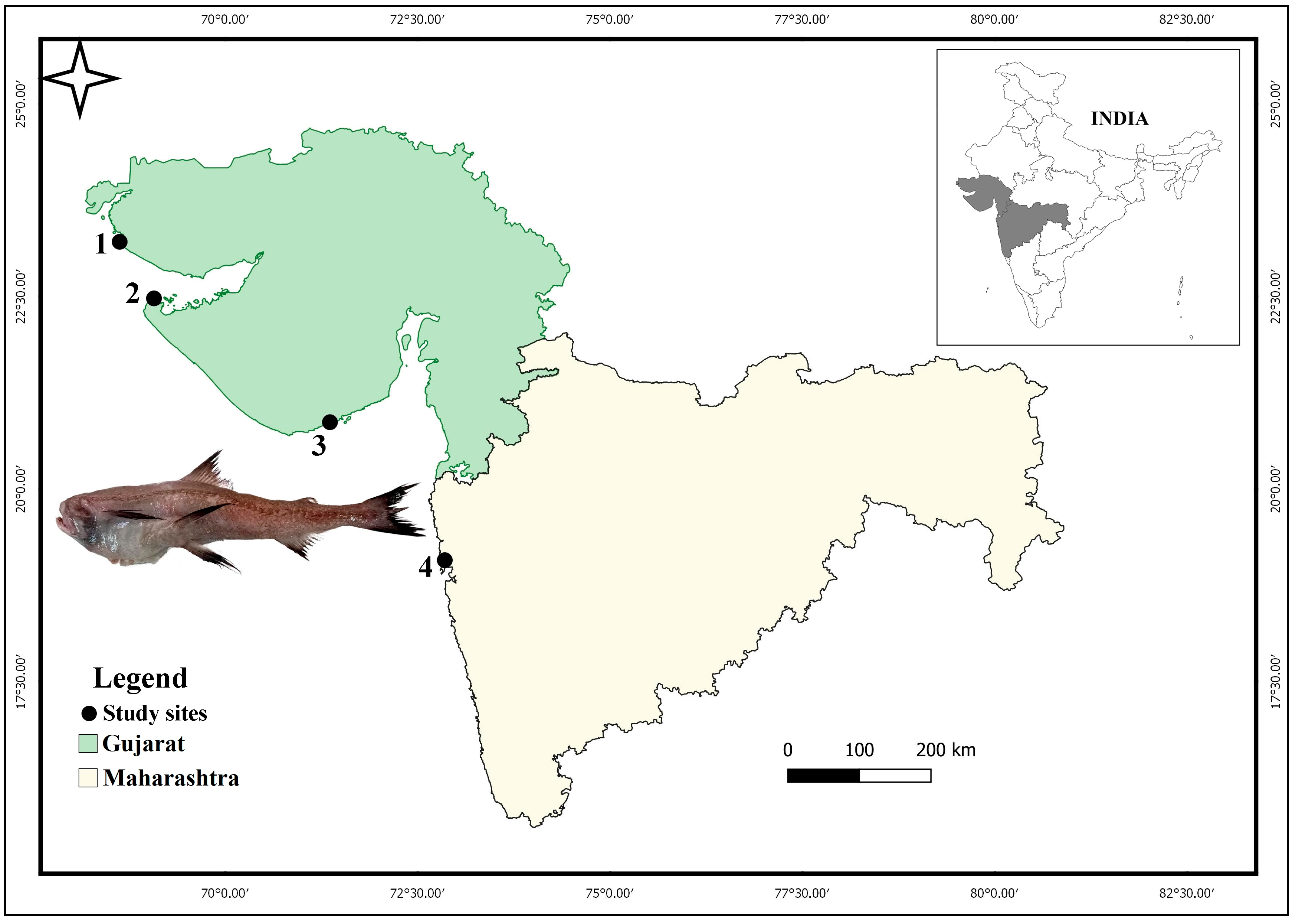
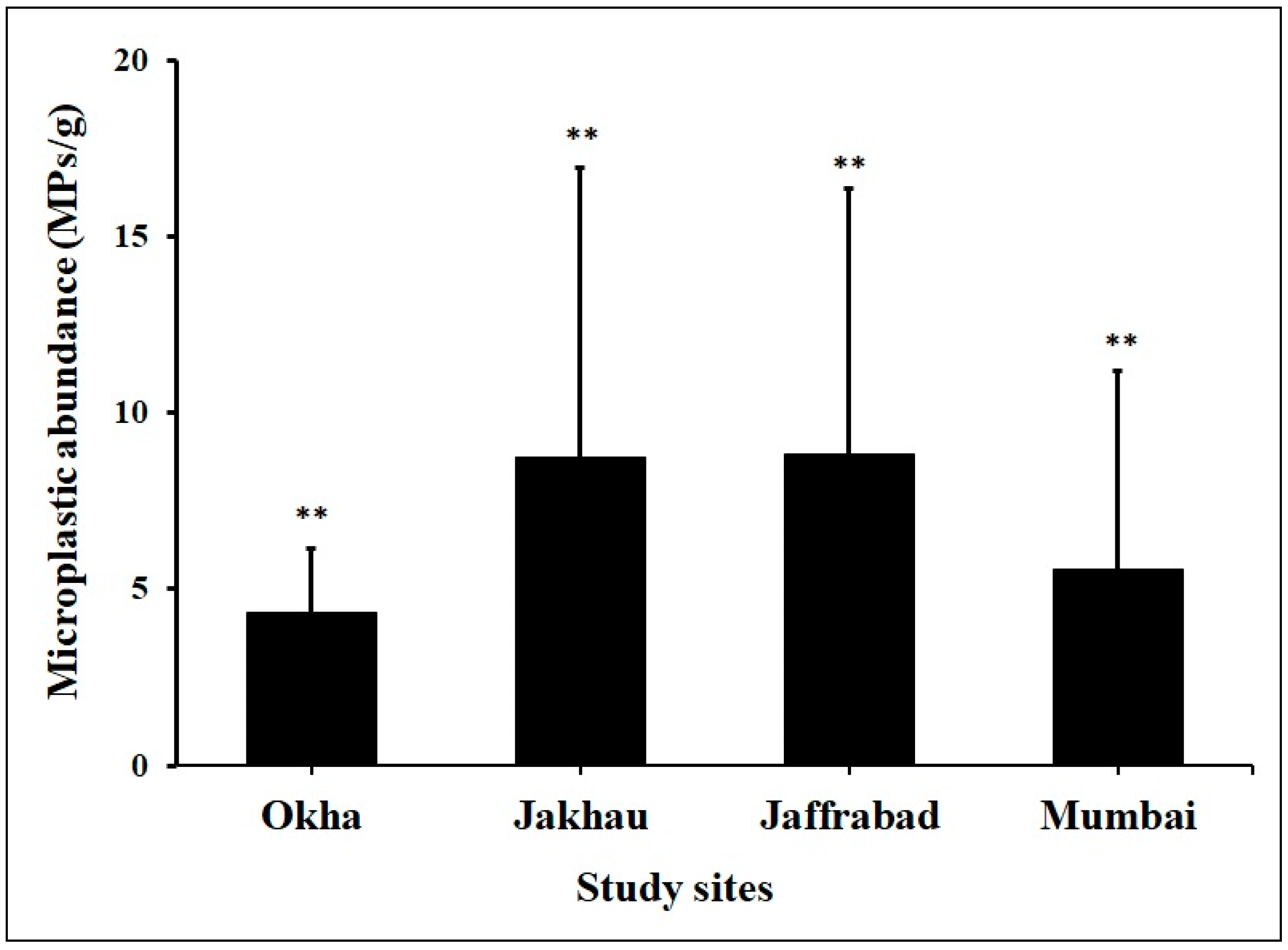

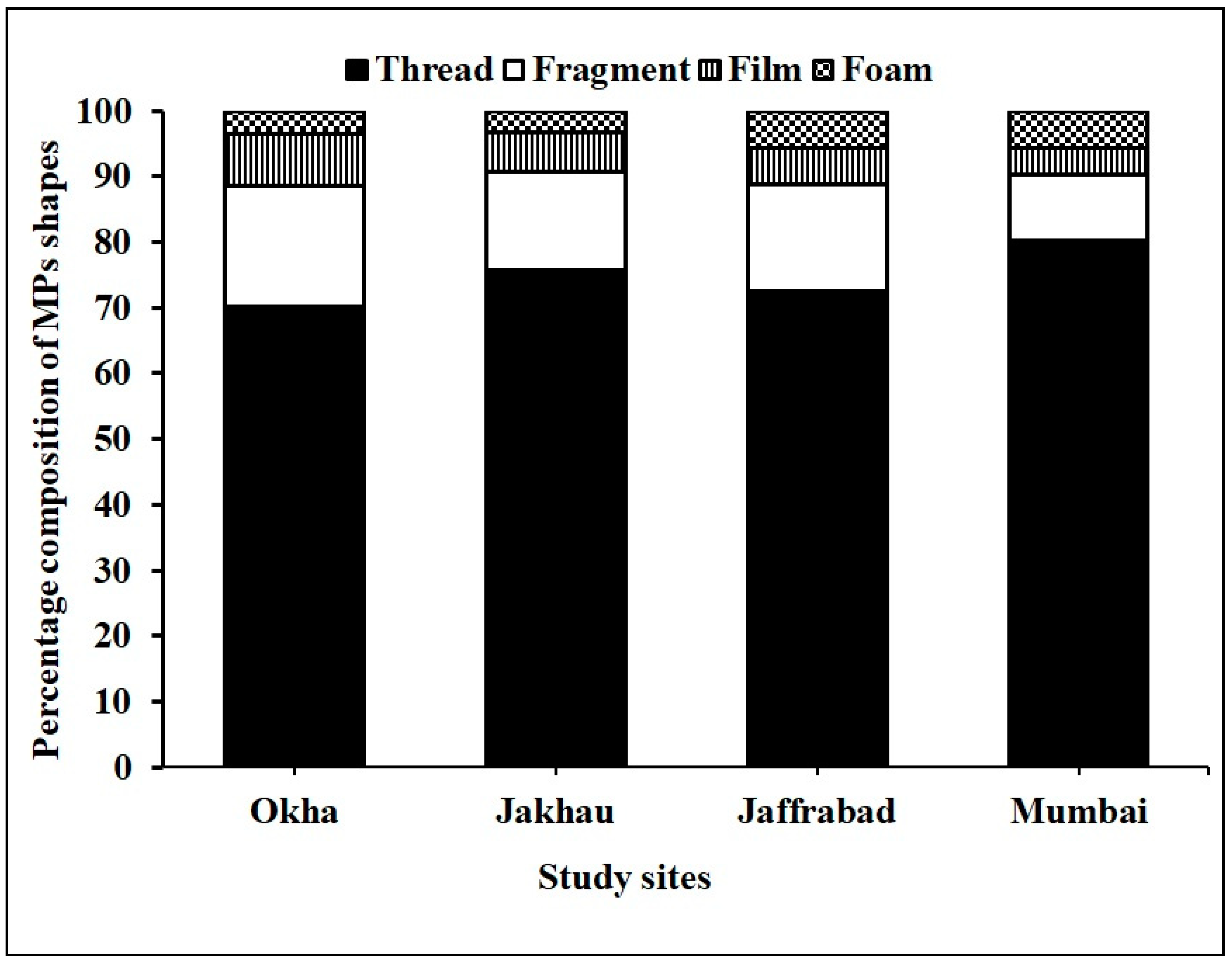

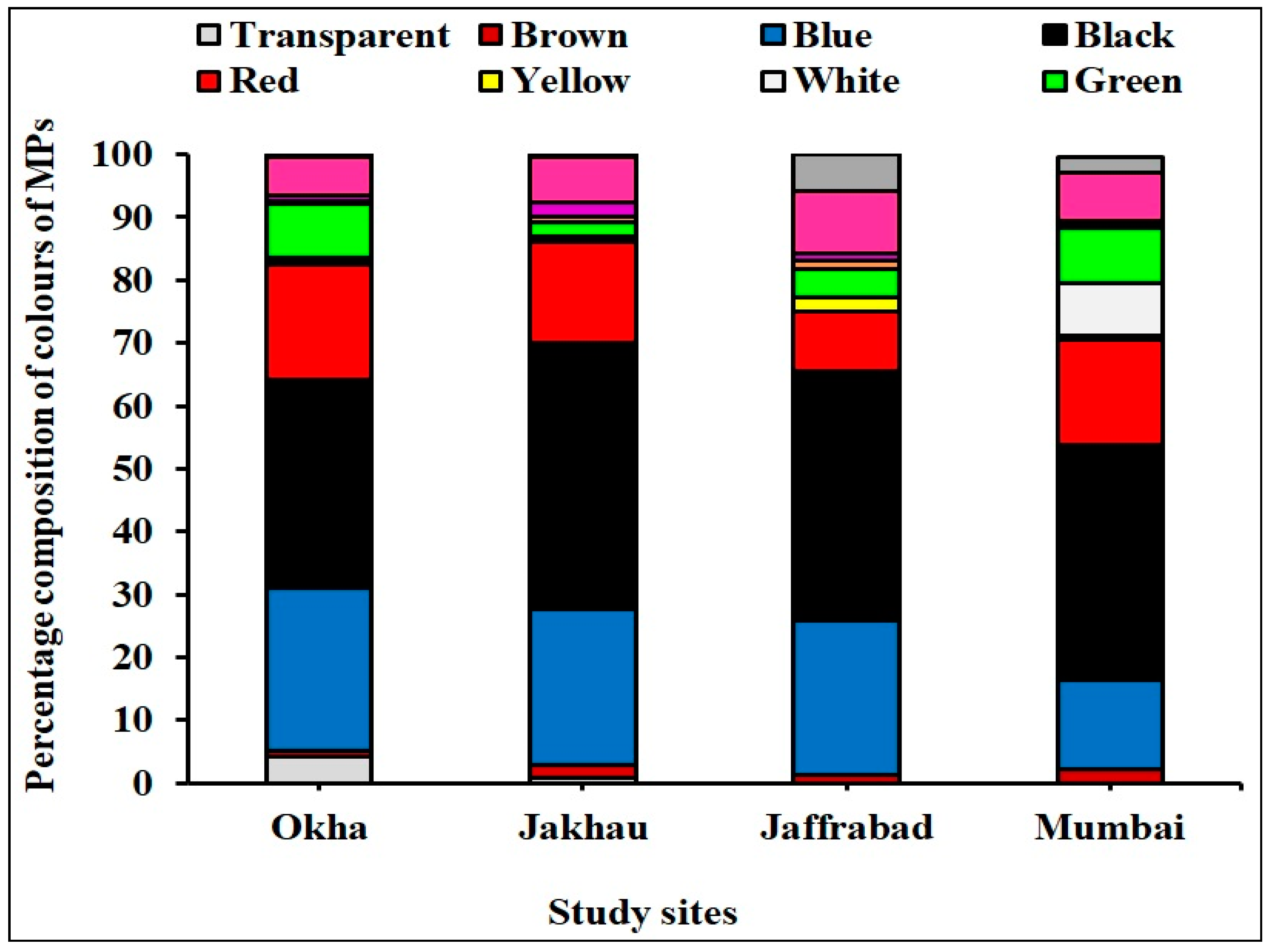
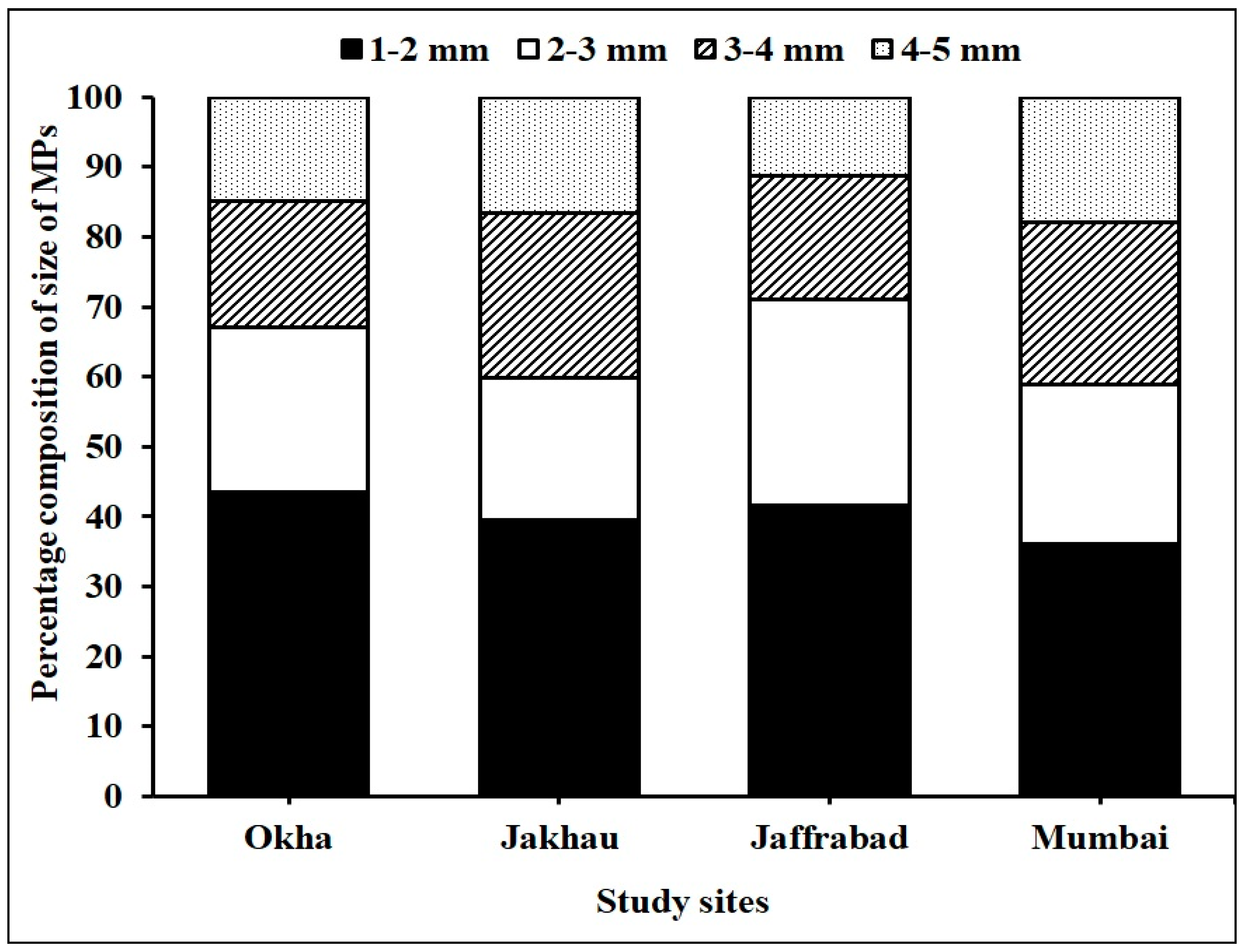

| Jaffrabad | Jakhau | Mumbai | |
|---|---|---|---|
| Jakhau | 0.85179 | - | - |
| Mumbai | 0.00172 | 0.00025 | - |
| Okha | 0.00172 | 0.00015 | 0.85179 |
Disclaimer/Publisher’s Note: The statements, opinions and data contained in all publications are solely those of the individual author(s) and contributor(s) and not of MDPI and/or the editor(s). MDPI and/or the editor(s) disclaim responsibility for any injury to people or property resulting from any ideas, methods, instructions or products referred to in the content. |
© 2023 by the authors. Licensee MDPI, Basel, Switzerland. This article is an open access article distributed under the terms and conditions of the Creative Commons Attribution (CC BY) license (https://creativecommons.org/licenses/by/4.0/).
Share and Cite
Prusty, K.; Rabari, V.; Patel, K.; Ali, D.; Alarifi, S.; Yadav, V.K.; Sahoo, D.K.; Patel, A.; Trivedi, J. An Assessment of Microplastic Contamination in a Commercially Important Marine Fish, Harpadon nehereus (Hamilton, 1822). Fishes 2023, 8, 432. https://doi.org/10.3390/fishes8090432
Prusty K, Rabari V, Patel K, Ali D, Alarifi S, Yadav VK, Sahoo DK, Patel A, Trivedi J. An Assessment of Microplastic Contamination in a Commercially Important Marine Fish, Harpadon nehereus (Hamilton, 1822). Fishes. 2023; 8(9):432. https://doi.org/10.3390/fishes8090432
Chicago/Turabian StylePrusty, Kalpana, Vasantkumar Rabari, Krupal Patel, Daoud Ali, Saud Alarifi, Virendra Kumar Yadav, Dipak Kumar Sahoo, Ashish Patel, and Jigneshkumar Trivedi. 2023. "An Assessment of Microplastic Contamination in a Commercially Important Marine Fish, Harpadon nehereus (Hamilton, 1822)" Fishes 8, no. 9: 432. https://doi.org/10.3390/fishes8090432






